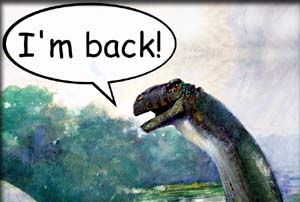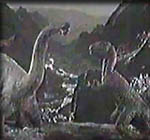|
|
|
|

The
name Brontosaurus, once relegated to the trash bin
of science, may be back.
|
Science
Over the Edge
A
Roundup of Strange Science for the Month
May
2015
|
|
In the
News:
 The
Brontosaurus is Back! - In the 1870's famous paleontologist
Othniel Charles Marsh described a species of sauropod dinosaur
giving it the name Brontosaurus (Thunder Lizard).
In 1903, however, another researcher decided that the Brontosaurus
was actually the same as another species Marsh had found,
the Apatosaurus. What followed as a long argument
over whether using the old name, Brontosaurus was a sign
of scientific illiteracy. Well, things have changed for
the brontosaurus again. Emanuel Tschopp a researcher at
Unversidade Nova de Lisboa in Portugal has led a very detailed
study of the evolutionary relationships of groups of sauropods
and come to the startling conclusion that the Brontosaurus
actually is a distinct species from Apatosaurus. "The differences
we found between Brontosaurus and Apatosaurus were at least
as numerous as the ones between closely related genera,
and much more than what you normally find between species,"
remarked Roger Benson from University of Oxford and co-author
of the study. This may cause the Brontosaurus name to appear
again in books and museums. The paper was published in the
open access journal PeerJ. The
Brontosaurus is Back! - In the 1870's famous paleontologist
Othniel Charles Marsh described a species of sauropod dinosaur
giving it the name Brontosaurus (Thunder Lizard).
In 1903, however, another researcher decided that the Brontosaurus
was actually the same as another species Marsh had found,
the Apatosaurus. What followed as a long argument
over whether using the old name, Brontosaurus was a sign
of scientific illiteracy. Well, things have changed for
the brontosaurus again. Emanuel Tschopp a researcher at
Unversidade Nova de Lisboa in Portugal has led a very detailed
study of the evolutionary relationships of groups of sauropods
and come to the startling conclusion that the Brontosaurus
actually is a distinct species from Apatosaurus. "The differences
we found between Brontosaurus and Apatosaurus were at least
as numerous as the ones between closely related genera,
and much more than what you normally find between species,"
remarked Roger Benson from University of Oxford and co-author
of the study. This may cause the Brontosaurus name to appear
again in books and museums. The paper was published in the
open access journal PeerJ.
 Fast
Charging Aluminum Battery in the Works - Scientists
are demonstrating a new aluminum-ion battery prototype that
can be recharged in only 60 seconds that my eventually find
its way into our cell phones. Its only drawback? Not quite
enough power. "Our battery produces about half the voltage
of a typical lithium battery," said Hongjie Dai, a professor
of chemistry at Stanford, and part of the development team.
"But improving the cathode material could eventually increase
the voltage and energy density. Otherwise, our battery has
everything else you'd dream that a battery should have:
inexpensive electrodes, good safety, high-speed charging,
flexibility and long cycle life." Scientist have been trying
to use aluminum in a battery for quite some time, but haven't
been able to pack enough power into one for it to be practical.
This new design, however, uses an aluminum anode and graphite
cathode, with an ionic liquid electrolyte inside a flexible
polymer pouch, to create a battery that is both cheap and
safe. Fast
Charging Aluminum Battery in the Works - Scientists
are demonstrating a new aluminum-ion battery prototype that
can be recharged in only 60 seconds that my eventually find
its way into our cell phones. Its only drawback? Not quite
enough power. "Our battery produces about half the voltage
of a typical lithium battery," said Hongjie Dai, a professor
of chemistry at Stanford, and part of the development team.
"But improving the cathode material could eventually increase
the voltage and energy density. Otherwise, our battery has
everything else you'd dream that a battery should have:
inexpensive electrodes, good safety, high-speed charging,
flexibility and long cycle life." Scientist have been trying
to use aluminum in a battery for quite some time, but haven't
been able to pack enough power into one for it to be practical.
This new design, however, uses an aluminum anode and graphite
cathode, with an ionic liquid electrolyte inside a flexible
polymer pouch, to create a battery that is both cheap and
safe.
 African
Monkey Not So Extinct - Animals seem be going extinct
these days at an alarming rate, but at least one that was
lost has been found again. The Bouvier's red colobus monkey
has not been seen in the wild since the 1970s. However,
explorers Lieven Devreese of Belgium and GaŽl Elie Gnondo
Gobolo of the Republic of the Congo managed to track down
the rare primate and get pictures. There are a few species
of the red colobus monkey and scientists only knew about
Bouvier's from a century old set of museum specimens. The
monkey lives in groups in swampy woods along the Congo River.
The area has been damaged by logging, leading to the assumption
that the species went extinct. The expedition to find the
missing primate was supported through the crowdfunding website
Indiegogo, and money from the Wildlife Conservation Society. African
Monkey Not So Extinct - Animals seem be going extinct
these days at an alarming rate, but at least one that was
lost has been found again. The Bouvier's red colobus monkey
has not been seen in the wild since the 1970s. However,
explorers Lieven Devreese of Belgium and GaŽl Elie Gnondo
Gobolo of the Republic of the Congo managed to track down
the rare primate and get pictures. There are a few species
of the red colobus monkey and scientists only knew about
Bouvier's from a century old set of museum specimens. The
monkey lives in groups in swampy woods along the Congo River.
The area has been damaged by logging, leading to the assumption
that the species went extinct. The expedition to find the
missing primate was supported through the crowdfunding website
Indiegogo, and money from the Wildlife Conservation Society.
 Man
With Metal Detector Makes Major Find - Researchers announced
that a man, searching for coins in a field in England, has
come across an important Roman grave site. Last October
Phil Kirk took his metal detector out into a field in Kelshall,
a village located halfway between London and Cambridge,
and found a buried bronze jug and a bronze patera. He then
contacted local experts to check the site. They believe
Kirk has stumbled upon the find of a lifetime: a grave belonging
to a wealthy individual from around 200 A.D. Some of the
objects found include a bronze pin, an iron lamp, glassware
and a pair of shoes. There is also evidence of building
close to the site that might be a shrine or temple. Man
With Metal Detector Makes Major Find - Researchers announced
that a man, searching for coins in a field in England, has
come across an important Roman grave site. Last October
Phil Kirk took his metal detector out into a field in Kelshall,
a village located halfway between London and Cambridge,
and found a buried bronze jug and a bronze patera. He then
contacted local experts to check the site. They believe
Kirk has stumbled upon the find of a lifetime: a grave belonging
to a wealthy individual from around 200 A.D. Some of the
objects found include a bronze pin, an iron lamp, glassware
and a pair of shoes. There is also evidence of building
close to the site that might be a shrine or temple.
 More
Magma Under Supervolanco - Yellowstone magma reserves
are much larger than previously thought according to a new
study by the University of Utah. Yellowstone is one of the
largest supervolcanos in the world producing immense eruptions
630,000 and 2 million years ago. Today, the volcano is quiet,
but its heat fuels Yellowstone's geological wonders like
geysers and mud pots. The scientists new estimate for the
total molten rock reserves is 13,700cubic miles, enough
to fill the grand canyon 14 times over. The team used the
shock waves from the 2,000 to 3,000 small earthquakes per
year that occur in the area to create an image of the two
magma chambers below the park. The upper one is 2,500 cubic
miles in size measures about 19 by 55 miles while the lower
one is 11,200 cubic miles and measures about 30 by 44 miles.
Scientists emphasize that this new information does not
increase the chance of the volcano having another eruption
in the near future. More
Magma Under Supervolanco - Yellowstone magma reserves
are much larger than previously thought according to a new
study by the University of Utah. Yellowstone is one of the
largest supervolcanos in the world producing immense eruptions
630,000 and 2 million years ago. Today, the volcano is quiet,
but its heat fuels Yellowstone's geological wonders like
geysers and mud pots. The scientists new estimate for the
total molten rock reserves is 13,700cubic miles, enough
to fill the grand canyon 14 times over. The team used the
shock waves from the 2,000 to 3,000 small earthquakes per
year that occur in the area to create an image of the two
magma chambers below the park. The upper one is 2,500 cubic
miles in size measures about 19 by 55 miles while the lower
one is 11,200 cubic miles and measures about 30 by 44 miles.
Scientists emphasize that this new information does not
increase the chance of the volcano having another eruption
in the near future.
|
|
 Science
Quote of the Month - "The
greatest discoveries of science have always been those that
forced us to rethink our beliefs about the universe and
our place in it." - Robert L. Park Science
Quote of the Month - "The
greatest discoveries of science have always been those that
forced us to rethink our beliefs about the universe and
our place in it." - Robert L. Park
|
|
What's
New at the Museum:
 Whatever
Happened to the Brontosaurus? - This giant dinosaurs
is suddenly back in the news, but why did he ever leave?
- Full Story Whatever
Happened to the Brontosaurus? - This giant dinosaurs
is suddenly back in the news, but why did he ever leave?
- Full Story
 Mysterious
Picture of the Month - What
is this this? Mysterious
Picture of the Month - What
is this this?

|
|
Ask
the Curator:
 Disappearing
Ship - I'm a fan of the movie, "Close Encounters
of the Third Kind" and have wondered about the ship, the
"Cotopaxi," they discover in the desert. Was it supposedly
lost in the "Bermuda Triangle?" Thanks. -Anonymous Disappearing
Ship - I'm a fan of the movie, "Close Encounters
of the Third Kind" and have wondered about the ship, the
"Cotopaxi," they discover in the desert. Was it supposedly
lost in the "Bermuda Triangle?" Thanks. -Anonymous
If
you only saw Stephen Spielberg's classic film in the theaters
in 1977, you never saw this scene as it was deleted from
the final cut in. However, when the "Directors Cut"
was released in 1980 it was included. It the scene shows
several bewildered investigators as they come across a tramp
steamer perched on a sand dune in the Gobi Desert.
The
real SS Cotopaxi was a steamer that disappeared in
December o f 1925 on a trip from Charleston, South Carolina,
to Havana, Cuba, while hauling coal. It is generally listed
as one of the ships that disappeared mysteriously in the
Bermuda Triangle, but when it did go missing it seems likely
that a large storm was going on in the area. It gave a distress
call on December 1st that the ship was in trouble, listing
and taking on water. It went down with a crew of 32 on board.
The
model used in the film did not look like the actual ship.
Have
a question? Click here to
send it to us.
|
| In
History:
 Van
Allen Belts - On May 4th of 1959 James. A. Van Allen
was featured on the cover of TIME magazine in recognition
of his discovery of the powerful radiation belts that surround
Earth. Allen had given a paper about his findings to the
joint sysmposium of the National Academy of Sciences and
the American Physical Society earlier. Allen used data from
the Explorer I and Pioneer III space probes to conclude
that the Earth was surrounded by these concentrations of
electrically charged particles. Van
Allen Belts - On May 4th of 1959 James. A. Van Allen
was featured on the cover of TIME magazine in recognition
of his discovery of the powerful radiation belts that surround
Earth. Allen had given a paper about his findings to the
joint sysmposium of the National Academy of Sciences and
the American Physical Society earlier. Allen used data from
the Explorer I and Pioneer III space probes to conclude
that the Earth was surrounded by these concentrations of
electrically charged particles.
|
|
In
the Sky:
 Aquarids
Shower - On May 5 and 6th you will get a view of the
Eta Aquarids Meteor Shower. This shower is debris left behind
by comet Halley as it makes its way around the sun. The
meteors will appear to come from the constellation Aquarius.
Unfortunately viewing will not be optimal this year as there
is a full moon on the 4th. Aquarids
Shower - On May 5 and 6th you will get a view of the
Eta Aquarids Meteor Shower. This shower is debris left behind
by comet Halley as it makes its way around the sun. The
meteors will appear to come from the constellation Aquarius.
Unfortunately viewing will not be optimal this year as there
is a full moon on the 4th.
|
|
Observed:
 Kermit's Wild Twin - Scientists have found a new species
of frog in Costa Rica that looks a lot like the famous thespian
frog, Kermit. Both Muppet Kermit and Hyalinobatrachium
dianae have pale green skin and bulging eyes. This new
species is a type of glassfrog. Glassfrogs have translucent
skin on the belly and the internal organs are visible from
underneath. Researcher Brian Kubicki of the Costa Rican
Amphibian Research Center and along with Stanley Salazar
and Robert Puschendorf were responsible for the discovery.
Kermit's Wild Twin - Scientists have found a new species
of frog in Costa Rica that looks a lot like the famous thespian
frog, Kermit. Both Muppet Kermit and Hyalinobatrachium
dianae have pale green skin and bulging eyes. This new
species is a type of glassfrog. Glassfrogs have translucent
skin on the belly and the internal organs are visible from
underneath. Researcher Brian Kubicki of the Costa Rican
Amphibian Research Center and along with Stanley Salazar
and Robert Puschendorf were responsible for the discovery.
|
|
LGM:

Zeep
and Meep are on a well deserved vacation. In their place
we feature highlights from their past adventures.
LGM
Archive 1998, 1999, 2000, 2001, 2002, 2003, 2004, 2005, 2006, 2007,
2008, 2009,
2010, 2011,
2012,
2013,
2014

Copyright Lee Krystek 2015. All Rights Reserved.
|
|
|
|





